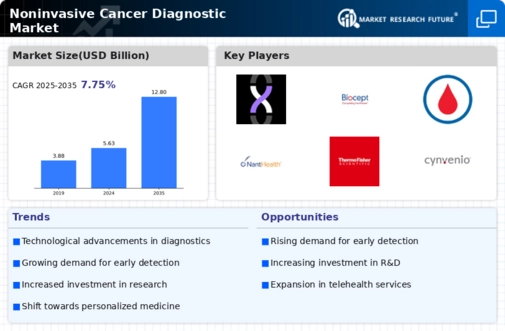Rising Incidence of Cancer
The increasing prevalence of cancer worldwide is a primary driver for the Noninvasive Cancer Diagnostic Market. According to recent statistics, cancer cases are projected to rise significantly, with estimates suggesting that by 2040, the number of new cancer cases could reach over 27 million annually. This alarming trend necessitates the development of effective diagnostic tools that can detect cancer at earlier stages, thereby improving patient outcomes. Noninvasive diagnostic methods, which minimize patient discomfort and risk, are becoming increasingly favored. As healthcare systems strive to manage the growing burden of cancer, the demand for innovative noninvasive diagnostic solutions is likely to surge, propelling the Noninvasive Cancer Diagnostic Market forward.
Shift Towards Preventive Healthcare
The Noninvasive Cancer Diagnostic Industry. As healthcare systems increasingly prioritize prevention over treatment, there is a growing emphasis on early detection and risk assessment. Noninvasive diagnostic tools align perfectly with this paradigm shift, offering a means to identify potential health issues before they escalate into serious conditions. The market for preventive diagnostics is projected to expand rapidly, with noninvasive methods playing a pivotal role in this transformation. This trend is likely to drive investments in research and development, further enhancing the capabilities of noninvasive diagnostics and solidifying their position within the Noninvasive Cancer Diagnostic Market.
Advancements in Diagnostic Technologies
Technological innovations are transforming the landscape of the Noninvasive Cancer Diagnostic Market. Recent advancements in imaging techniques, biomarker discovery, and molecular diagnostics have enhanced the accuracy and efficiency of cancer detection. For instance, liquid biopsy technologies, which analyze circulating tumor DNA, are gaining traction due to their ability to provide real-time insights into tumor dynamics. The market for liquid biopsies alone is expected to reach several billion dollars by 2026, reflecting the growing reliance on noninvasive methods. These advancements not only improve diagnostic precision but also facilitate personalized treatment approaches, thereby driving the demand for noninvasive diagnostics in oncology.
Growing Awareness and Screening Initiatives
Increased awareness about cancer and the importance of early detection is significantly influencing the Noninvasive Cancer Diagnostic Market. Public health campaigns and screening initiatives are encouraging individuals to undergo regular check-ups, leading to higher rates of cancer diagnosis at earlier stages. For example, initiatives aimed at promoting breast and cervical cancer screenings have shown positive results in increasing participation rates. This heightened awareness is likely to drive the demand for noninvasive diagnostic tools, as patients and healthcare providers seek less invasive options for screening and monitoring. Consequently, the Noninvasive Cancer Diagnostic Market is expected to benefit from this trend as more individuals opt for noninvasive testing methods.
Regulatory Support and Reimbursement Policies
Supportive regulatory frameworks and favorable reimbursement policies are crucial factors propelling the Noninvasive Cancer Diagnostic Market. Governments and health authorities are increasingly recognizing the value of noninvasive diagnostic methods in improving patient care and reducing healthcare costs. As a result, there is a growing trend towards establishing reimbursement pathways for noninvasive tests, which enhances their accessibility and affordability. For instance, several countries have implemented policies that cover the costs of liquid biopsies and other noninvasive diagnostic procedures. This regulatory support not only encourages innovation but also fosters market growth, as healthcare providers are more likely to adopt noninvasive solutions when they are financially viable.

















Leave a Comment